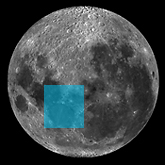 |
CHAMÄLEON + ONJALA OBSERVATORY – LUNAR
ATLAS Segment 05 A |
back to OVERVIEW HOME CHAMÄLEON |
|
 |
|||
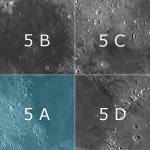
|
Segment 5 A FF - crater Posidonius, Lava borders in Mare Tranquilitatis, The Apollo 17 region with its pyroclastic deposits and the lunar cones Isis and Osiris. Segment 5 B Gardner megaplateau, Domefield Cauchy west, Jansen and Carrel, Menelaus and Arago Segment 5 C Hyginus, Murchinson, Manilius and Yangel (Sinus Fidei) Segment 5 D Aristillus, Autolycus, Rima Hadley (Apollo 15), Palus Putredinus, Valentine Dome |
| Moon age 5.5 - 6.1 days - Illumination 25 - 30 %
FFC-crater Posidonius Lunar cones Isis and Osiris Pyroclastic deposit near Apollo 17 |
Moon age 7.1 days -
Illumination 40 % FFC-crater Posidonius Pyroclastic deposit near Apollo 17 |
Moon age 14.8 days - Illumination 100 % Lava borders in Mare Serenitatis |
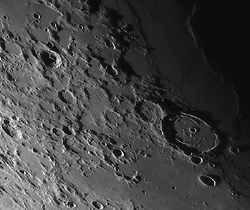 |
FFC - crater Posidonius - Moon age 5.5 days (25 %) Posidonius (95 km) at sunrise is a splendid floor fractured crater and located on the northwestern edge of Mare Serenitatis. The crater is clearly tilted toward the center of Mare Serenitatis. East of Posidonius is the extensive system of rilles G. Bond. The crater floor shows two different faces. The eastern half is furrowed by rilles and shows the remnants of a central mountain. From the eastern crater wall towards the central area there is a curved ridge. The western crater floor is covered by a smooth lava field. At the western crater wall there is a remarkable sinusoidal rille. The structures are clearly visible at a Moon age of .7.1 days. |
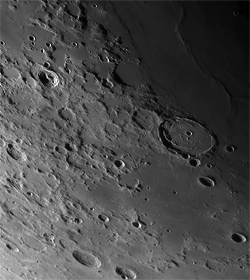 |
FF - crater Posidonius and
Franklin - Moon age 6.1
days (30 %) Posidonius half a day later than in the picture above. The crater interior is now clearly visible. In the northeast there is Franklin (56 km), one of the few FF crater which are not located directly on a Mare edge. |
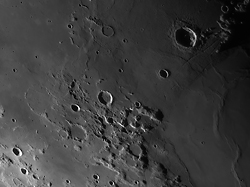 |
Gardner megadome - Moon age 6.1 days (30 %) The area around the 19 km wide crater Gardner is classified as a putative megadome plateau in the literature. It has a diameter of about 80 kilometers, making it the largest of these plateaus on the front side of the Moon. To the west there are the Taurus-Littrow mountains (landing site of Apollo 17) with the large-scale pyroclastic deposits. The area in the south and southwest include the large dome fields around the crater Jansen and Cauchy. Because of the overlap to Jansen and Cauchy you can see more images in Segment 5 B. |
 |
Osiris, Isis and
Apollo 17 - Moon age 6.1
days (30 %) Osiris and Isis are classified as lunar cones, in principle lunar domes but much smaller in diameter. They rarely exceed a diameter of 4 to 5 km. Both domes have an elongated structure with elongated vent openings. Isis is associated with a small sinusoidal rille, which is interpreted as outflow channel (in this image is not visible). The heights are 60 meters (Isis) and 70 meters (Osiris). Both structures are just under 1 000- and 600 meters and therefore at the limit of the Celestron 14 resolution. They can be only detected in this illumination situation. In our image the position of "Bear Mountain" is highlighted in the Taurus-Littrow mountains. Next to it there is the landing site of Apollo 17. |
 |
FF - crater Posidonius - Moon age 7.1 days (40 %) At an illumination of about 40 % the curved mountain range on the eastern crater wall and the sinusoidal rille on the western crater wall are clearly visible. |
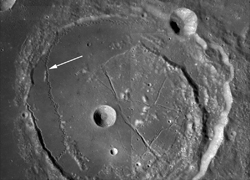 |
LRO Posidonius The image shows a high-resolution LRO image of the sinusoidal rille in the crater Posidonius. The many wounded loops suggest that it was formed by highly liquid (low viscosity) and very hot lava. |
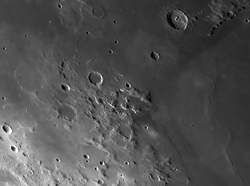 |
Pyroclastic deposit near the Apollo 17
landing site - Moon age 7.1 days (40
%) This image shows the cyroclastic deposit near the landing site of Apollo 17. Some samples of the yellowish volcanic glass were brought back by the astronauts to the Earth. The astronauts described the material as "orange soil". The landing site near Bear Mountain is marked in the image. |
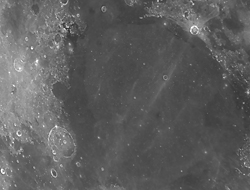 |
Pyroclastic deposit near the Apollo 17
landing site - Moon age 14.8 days (100
%) The two following images date back to 2007 and were recorded under full Moon conditions. The images show very nicely the lavaborders due to their different chemical composition in various shades of gray. Very dark appears the pyroclastic Deposit near the landing site of Apollo 17. |
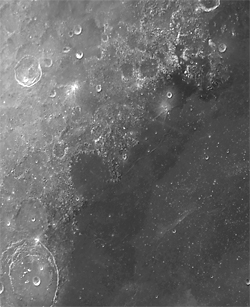 |
Lavaborders in Mare Serenitatis -
Moon age 14.8 days (100 %) Interesting in this imagee are the craterlets in the large crater Le Monnier (60 km). Under other lighting conditions the Celestron 14 only shows a uniform smooth lava field and the small craters are not visible. |
| top of the page |
 |
 |
 |
 |
 |
 |
 |
 |
 |
 |
 |
 |
| Segm. 01 | Segm. 02 | Segm. 03 | Segm. 04 | Segm. 05 | Segm. 06 | Segm. 07 | Segm. 08 | Segm. 09 | Segm. 10 | Segm. 11 | Segm. 12 |